I realize that it’s now been about two and a half weeks since the festivities at Pro Circuit Los Angeles. But since we just finished two weeks worth of previews for the Legion of Super Heroes set, I haven’t had the chance to expound upon the events of the PC weekend. The metagame for the new Golden Age appears to be much more diverse than anyone could have ever anticipated. The prediction of the new reign of High Voltage and other early-game decks was trumped by the appearance of innovative control and stall builds—notably FTN’s Crisis Doom and the new and improved TDC Stall. In the end, though, it was Metagame.com’s own Adam Prosak who took home the title of PC Champion with his variant of a Doom-based counter deck similar to the one that I posted a few weeks back (though much more refined).
Sadly, the furious fighters of TAWC failed to place anyone in the money in the PC. This was due to two factors: our deck missed the metagame call and only placed two of five members into Day 2, and the two TAWC members who did make Day 2 (me and John Hall) were both completely inept at drafting Heralds of Galactus. Still, as disappointed as our team was at our poor showing at PC: LA, we had a good time overall. It’s never hard to have fun when you’ve got such dynamic personalities on a team!
The weekend was certainly a variety of extremes for me. On one hand, I lost my bet with Alex “I talk too much” Tennet, and have been forever dubbed “Barnacle.” I suppose that this was an inevitability anyway, considering that you can’t actually spell my last name without “barn.” Fortunately, my sorrow at being bested by FTN’s big-mouthed Brit turned to joy when Alex attempted to best my teammate Jeremy Blair in a battle of wits. The collective members of TAWC and FTN went to dinner together on Saturday evening. Over the course of the meal, Alex and Jeremy exchanged verbal jabs in what turned out to be a rather severe beating on Mr. Tennet. As witty as Alex claims to be, he was no match for the Kingpin. Jeremy had everyone on both teams rolling with laughter at his thorough vocal demolition of Alex . . . so much so that I was shooting soda out of my nose by the end of the evening!

All in all, it was a fine weekend. While placing in the money would have been nice, it’s important to note that you can still have a positive PC experience even if you don’t do well. I suppose the fact that my team loves Vs. System (and, more recently, World of Warcraft) makes it easy for us to enjoy playing even when we aren’t playing very well.
How to Build a Deck to Compete Within the Metagame
Generally, my team is pretty good at predicting the metagame for any given format. In the three PCs prior to PC: LA, we had developed decks that were strong competitors within the established metagame. Following PC: LA, though, I came to realize that I might be oversimplifying my analysis. Modern Age metagames are not too difficult to predict given the limited card pool available (though this will probably change when the Modern Age format expands to four sets). The Silver Age metagame is a bit more difficult, as we were trying to extrapolate a metagame in a format with which we had no experience up until that point. Our initial prediction was that PC: San Francisco would be rife with Good Guys, Squadron Supreme, Anti-Green Lantern, and Faces of Evil. This prediction was not as accurate as we would have liked. While there were plenty of Good Guys and Squadron Supreme decks, AGL and Faces of Evil were largely absent. Moreover, TDC’s Ivy League deck and FTN’s Mexican Hardware Store deck were complete surprises to us. We were fortunate in the fact that our deck had solid matchups against these decks.
 This helps to explain what happened at PC: LA. Our prediction for the Golden Age metagame was a lot of Teen Titans and High Voltage. Using that prediction, my team’s deck choice of Quicksilver Fate was a good call. But it turned out that the dominant decks within the Golden Age metagame were decks that beat those two decks—Crisis Doom, TDC Stall (part deux), and Devil’s Due. Unfortunately, those decks were all difficult matchups for our deck. While we could beat most decks that could not control the early game, it was very difficult for us to contend with anything that could disrupt our deck. In several of my losses, it was a single copy of Meltdown that turned the game from probable victory to certain defeat.
This helps to explain what happened at PC: LA. Our prediction for the Golden Age metagame was a lot of Teen Titans and High Voltage. Using that prediction, my team’s deck choice of Quicksilver Fate was a good call. But it turned out that the dominant decks within the Golden Age metagame were decks that beat those two decks—Crisis Doom, TDC Stall (part deux), and Devil’s Due. Unfortunately, those decks were all difficult matchups for our deck. While we could beat most decks that could not control the early game, it was very difficult for us to contend with anything that could disrupt our deck. In several of my losses, it was a single copy of Meltdown that turned the game from probable victory to certain defeat.
So what is the lesson to be learned here? Well, the key is that when you are playing at a competitive level, you want to have a deck that can beat the predicted metagame and adapt to any surprises in the metagame. This was the key difference between my team’s success at PC: San Francisco with Checkmate / Villains United and our difficulty at PC: LA with Quicksilver Fate.
Beating the Metagame
Now for the fun stuff. Following every PC, I like to look at the successful decks from that PC and figure out what common themes (if any) exist between them. If you can find these themes, then you can also find a route to success against the decks that will define the Vs. System metagame for the months to come.
Looking at the top decks from PC: LA, we’ll find a universally well-defined theme: resource row dependency. In the early days of Vs. System, there were decks that could pretty much ignore the resource row completely and still compete quite well. For example, most of the early Fantastic Four beatdown decks didn’t play a single location or ongoing plot twist. This left them free of any resource row disruption effects that their opponents might have for them. Later on, Curve Sentinels took the cue from the Fantastic Four. Some tech cards like Micro-Sentinels and Total Anarchy made occasional appearances in the Sentinel decks, but Sentinels operated for the most part independently of the cards in the resource row.
 As Vs. System has developed, though, people have begun to stand up and take notice of how powerful a tool the resource row can be. First and foremost, the resource row is the only area where locations can be put to significant use. In the early sets, there were precious few locations worth playing in competitive decks. But as the game has developed, the power of locations has increased. More importantly, characters like Poison Ivy, Deadly Rose and Ahmed Samsarra have made location search extremely easy—so much so that the prominence of locations has increased significantly.
As Vs. System has developed, though, people have begun to stand up and take notice of how powerful a tool the resource row can be. First and foremost, the resource row is the only area where locations can be put to significant use. In the early sets, there were precious few locations worth playing in competitive decks. But as the game has developed, the power of locations has increased. More importantly, characters like Poison Ivy, Deadly Rose and Ahmed Samsarra have made location search extremely easy—so much so that the prominence of locations has increased significantly.
Of course, the improved power in locations has been matched by the power of ongoing plot twists. With cards like Enemy of My Enemy allowing for an unparalleled level of off-team search, Team-Ups have become a lot more potent. In addition, ongoing plot twists like Political Pressure, Unmasked, and Devil’s Due have become tech cards (or even archetypes) for Golden Age decks to use and abuse.
The irony of all of this resource row love is that there really hasn’t been an equivalent development of resource row hate. Long gone are the times when cards like Have a Blast! and Breaking Ground were standards in control decks. Instead, these cards have taken a back seat to more board control–oriented cards. While these decks may now be more capable of dominating in terms of board control, they tend to ignore the opposing resource rows completely. Given that resource row utility in Vs. System is greater now than it has ever been, this seems like a woeful oversight to me.
“The Source” of all Resource Row Hate
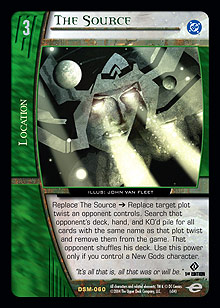 Thinking about resource row disruption got me to thinking about one of my favorite cards in Vs. System: The Source. There have been two prominent statements made about The Source since its release in Superman, Man of Steel: it is an amazing card, and it is team-stamped to a team that will never be able to compete at a significant level. For the most part, these statements have been and continue to be true.
Thinking about resource row disruption got me to thinking about one of my favorite cards in Vs. System: The Source. There have been two prominent statements made about The Source since its release in Superman, Man of Steel: it is an amazing card, and it is team-stamped to a team that will never be able to compete at a significant level. For the most part, these statements have been and continue to be true.
But the recent popularity (and power) of the teams from Heralds of Galactus got me thinking about that second statement. In general, the New Gods weren’t viable because they didn’t have enough strong characters to support a mono-team deck and teaming them up with another, stronger team generally produced a collaboration that was weaker than simply playing the other team alone. Still, it is worth considering playing the New Gods just to have the power of The Source at your disposal.
My recent pet deck is a Heralds of Galactus / Inhumans team-up build. It is reminiscent of the deck that Adam Prosak took to the Top 8 at $10K Columbus recently, but it spurns the Dr. Light, Master of Holograms / Poison Ivy engine in lieu of a more basic form of development. My mulligan condition is essentially for a 2-drop (San or Silver Surfer, Skyrider of the Spaceways). Getting one of these two into play pretty much ensures that I will be able to get Attilan online by turn 4. Attilan is an amazing card. When used in unison with Elemental Converters (much the way that I do in my Heralds / Inhumans deck), it provides the same benefit of a reusable Kooey Kooey Kooey or Kang, Kang Kong. . . without the associated cost! But even without the extra card draw, having the power to put any card in your deck on top of the deck is a very powerful tool.
It occurred to me at this point that I might have a neat combo here. Attilan puts any card on top of your deck. The Source wreaks havoc on your opponent’s resource row by replacing itself with the top card of your deck! We have a combo that not only totally messes with your opponent, but also gets you a free card in the bargain. Is there anything bad about this?
It’s time for the space-faring stalwarts, the New Gods, to hook up with the new cosmic kids on the block, the Inhumans. The result will hopefully be a mean collaboration where we use Attilan and The Source to set up the cards we want in our own resource row while, at the same time, doing irreparable damage to our opponent’s row.
The Build
We have a neat little curve from 1 to 8, so let’s get our character compliment settled. At 1, we have the ferocious yet lovable Lockjaw, Inhuman’s Best Friend. His stats, range, and concealed—optional make Lockjaw a fine play regardless of effects. Yet when we take into account that Lockjaw also allows us to search up an Inhumans character, he’s pretty much an auto-inclusion in our build.
Of course, our 2-drop will probably be our primary target for search with Lockjaw. Considering how much we plan to rely on key locations for our deck, San will be the character we want to play every time on turn 2. Our engine leans pretty heavily on Attilan to find cards for our immediate use, so Attilan will usually be the card that we find with San. If we already have a copy of Attilan available to us, then we can simply use San to find another location (like maybe The Source, hmmm?).
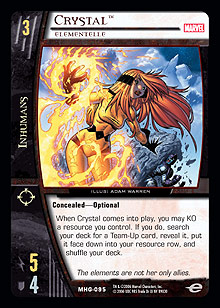 Our Inhumans representative at 3 is Crystal, Elementelle. Obviously, this deck will lean pretty heavily on a Team-Up between our two teams. Crystal is one of the best (if not the best) Team-Up search cards in Vs. System. Still, as great as Crystal is, we’d really like to put a New Gods character in play on turn 3. This is the reason we’ll be playing four copies of Sturmer. The war dog has a slight drawback in that he cannot attack unless he team attacks*, but he makes up for this deficiency by boasting a very impressive 4 ATK / 7 DEF. Perhaps more importantly, Sturmer retains utility even after turn 3 with a character search effect that is just phenomenal. With a single recursion card in play (like Slaughter Swamp), Sturmer pretty much guarantees that we will hit our late curve. With that kind of usefulness, Sturmer is a no-brainer for us.
Our Inhumans representative at 3 is Crystal, Elementelle. Obviously, this deck will lean pretty heavily on a Team-Up between our two teams. Crystal is one of the best (if not the best) Team-Up search cards in Vs. System. Still, as great as Crystal is, we’d really like to put a New Gods character in play on turn 3. This is the reason we’ll be playing four copies of Sturmer. The war dog has a slight drawback in that he cannot attack unless he team attacks*, but he makes up for this deficiency by boasting a very impressive 4 ATK / 7 DEF. Perhaps more importantly, Sturmer retains utility even after turn 3 with a character search effect that is just phenomenal. With a single recursion card in play (like Slaughter Swamp), Sturmer pretty much guarantees that we will hit our late curve. With that kind of usefulness, Sturmer is a no-brainer for us.
Our character compliment at 4 is very similar to the one at 3. We have a lone Inhumans representative in Triton. “Garth Jr.” is probably the most poorly regarded of the Inhumans 4-drops. While the recursion effect that he boasts is excellent, it is often difficult to get his cosmic counter. Of course, we’ll incorporate a few tricks to help Triton out. Our primary character at 4, though, will be Izaya ◊ Highfather. Highfather, much like Sturmer, is already a strong choice because of his impressive stats. But Highfather’s real strength lies in his recovery effect. With an effect like The Outside World that can move Highfather to the hidden area, we can actually give our deck a source of extra recovery each turn. With such sizable characters at our disposal, we should have little problem keeping board advantage over our opponents.
Valkyra kicks off our picks at 5. Were you wondering about those “tricks” that we might have to keep Triton from stunning? How about a +3 DEF boost from the Valkyrie of New Genesis? With more than a few characters with cosmic in our deck, Valkyra’s leader power is actually relevant; the fact that she’s 10 ATK / 10 DEF with her cosmic counter certainly doesn’t hurt. Our other 5-drop isn’t nearly as big as Valkyra, but it would be a grievous understatement to say that Karnak isn’t every bit as devastating. His stats are well below average for a 5-drop, but he has an effect that essentially reads, “Remove cosmic counter >>> Your smallest character can stun your opponent’s largest character.” It is absolutely absurd when Lockjaw is taking down 6-drops. Still, there it is . . . Karnak can make a big beater of any character.
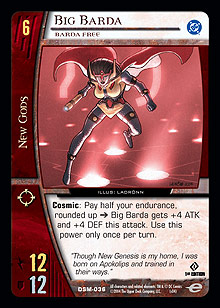 The play at 6 really depends on when the game is going to end. If we decide to go for a win on turn 7 or 8, then Big Barda is probably our play on turn 6. Initially she is an average 12 ATK / 12 DEF, but with her cosmic counter Big Barda can leap to 16 ATK / 16 DEF during a single attack. Sure, the price is pretty hefty, but there will certainly be times when the extra stat boost will be worth the cost. Now let’s consider our option if we wish to finish the game on turn 6. Since we plan to have all face-up resources, Maximus the Mad is an excellent finisher. Moving all of our opponent’s characters to the front row eliminates most reinforcement options that he or she might have, and gives us our choice of which opposing characters we’d like to attack. While Maximus is often maligned for his low DEF, he can be the proverbial nail in the coffin for our opponents if we control the initiative.
The play at 6 really depends on when the game is going to end. If we decide to go for a win on turn 7 or 8, then Big Barda is probably our play on turn 6. Initially she is an average 12 ATK / 12 DEF, but with her cosmic counter Big Barda can leap to 16 ATK / 16 DEF during a single attack. Sure, the price is pretty hefty, but there will certainly be times when the extra stat boost will be worth the cost. Now let’s consider our option if we wish to finish the game on turn 6. Since we plan to have all face-up resources, Maximus the Mad is an excellent finisher. Moving all of our opponent’s characters to the front row eliminates most reinforcement options that he or she might have, and gives us our choice of which opposing characters we’d like to attack. While Maximus is often maligned for his low DEF, he can be the proverbial nail in the coffin for our opponents if we control the initiative.
In many cases, we will try to go for the win on turn 7. For that, there is probably no better finisher than Invisible Woman, Flame On! Her DEF is well below where we’d like to see it, but she makes up for this with a burn effect that is just plain astounding. Whenever Invisible Woman goes into combat, she sets our opponents aflame for quite a bit of damage (usually 6 or more). Even if she does stun, she will usually dish out a lot more damage than she takes in the bargain.
At 8, we have the underappreciated Orion, Dog of War. There are certainly bigger 8-drops in the game, but Orion boasts a couple of effects that make him quite formidable. First, he has a built in Fizzle effect that can keep our opponents from using any combat tricks. Second, he has the ability to take an opposing attacker out of an attack at our discretion. Third, he’s an 8-drop! This fact alone makes him worth playing, as he will often be bigger than any character our opponent can play. Finally, since we’re already playing Lockjaw and Sturmer, I couldn’t resist playing the “Dog of War” as well!
Moving on to our plot twist selections, I have a bit of a rhetorical question for you: what does it mean when you play an Inhumans team-up deck with another team that has characters with powerful cosmic effects? Why, you’re obligated to play Extended Family, of course! Team-Ups are necessary for many multi-team decks to operate effectively, but when we have a card like Extended Family that can provide additional benefits for us, we’ve got a card that we can put to multiple good uses.
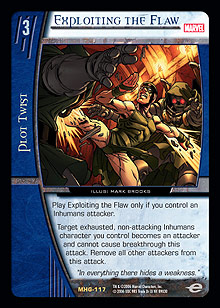 Now let’s consider some combat tricks. Despite the fact that we have some rather large defenders, we might want to have some defensive pumps to brickwall opposing attacks. For this, we will go to our old standby, Acrobatic Dodge. While it is one of the oldest plot twists in the game, it’s still one of the best defensive tricks in Vs. System. Another oldie but goodie, Flying Kick is the offensive counterpart to Acrobatic Dodge, providing a moderate turn-length ATK boost and flight to the targeted character. While we have a few characters with flight, it is a trait that is largely absent from our character selections, so Flying Kick is a strong pick for our ATK boost of choice. Of course, the turn-long boost can be quite useful when we consider our final combat trick, Exploiting the Flaw. I love this card! While it isn’t quite the equal of a card that gives you extra attacks (like Press the Attack), getting multiple attacks with a large character is still amazing. Imagine attacking a smaller character with Invisible Woman, dishing out a heap of endurance burn in the process, and then using Exploiting the Flaw to attack with her again and do another dose of burn on the second attack. Suffice to say, Exploiting the Flaw can be a great source of board advantage for us.
Now let’s consider some combat tricks. Despite the fact that we have some rather large defenders, we might want to have some defensive pumps to brickwall opposing attacks. For this, we will go to our old standby, Acrobatic Dodge. While it is one of the oldest plot twists in the game, it’s still one of the best defensive tricks in Vs. System. Another oldie but goodie, Flying Kick is the offensive counterpart to Acrobatic Dodge, providing a moderate turn-length ATK boost and flight to the targeted character. While we have a few characters with flight, it is a trait that is largely absent from our character selections, so Flying Kick is a strong pick for our ATK boost of choice. Of course, the turn-long boost can be quite useful when we consider our final combat trick, Exploiting the Flaw. I love this card! While it isn’t quite the equal of a card that gives you extra attacks (like Press the Attack), getting multiple attacks with a large character is still amazing. Imagine attacking a smaller character with Invisible Woman, dishing out a heap of endurance burn in the process, and then using Exploiting the Flaw to attack with her again and do another dose of burn on the second attack. Suffice to say, Exploiting the Flaw can be a great source of board advantage for us.
We have a couple of tech card choices to include. In Golden Age, it is probably a good call to play Political Pressure and Unmasked in any decks that can support them. Thanks to Attilan, we have a reliable search mechanism that can find these cards when we need them. In addition to these single-copy tech cards, we’re going to include a copy of Salvage. As we discussed earlier, we will (hopefully) be replacing The Source multiple times in a game. While we can’t rely on drawing multiple copies of The Source every game, we can use Salvage to fetch back used copies from the KO’d pile for future use. It’s a nifty combo that accelerates our draw and allows us to continue messing with our opponent’s resources.
While we already have plenty of search in our deck, a little extra help in the early turns probably wouldn’t hurt—specifically, finding a New Gods character for turn 3 or 4. This is why we’ll need a couple copies of The Exchange. This search card effectively allows us to increase the number of New Gods characters in our deck to six copies each. In order to get our engine online we need to have a New Gods character in the early turns for a Team-Up, and The Exchange is a simple way for us to get our important mid-game characters in hand.
Our final plot twist is a recovery trick that can greatly benefit our strategy. The Outside World is already a good card in that it gives us the opportunity to recover a stunned character, thus maintaining board presence. But the fact that it moves the recovered character into the hidden area is what really makes our strategy work. With a character like Highfather in the hidden area, we can all but ensure that we will maintain a stronger board position than our opponent. In addition, The Outside World can be an effective tool for recovering characters like Triton and Karnak before the recovery phase so that they can gain cosmic counters.
Obviously, we already have a couple of choice location selections for the deck in The Source and Attilan. Still, we could certainly benefit from some additional locations for our strategy. One that we would certainly like to have is Slaughter Swamp. We’ve already discussed how Sturmer can ensure that we hit our late drops, but that only works if we have a way of retrieving him from the KO’d pile to reuse him. Slaughter Swamp is probably the best call for us, as it can also be used to counter opposing Dr. Light, Master of Holograms activations.
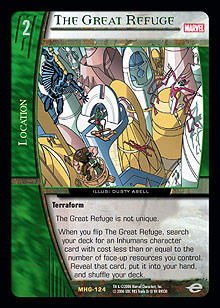 Now let’s take a look at a few terraform locations for our deck. Obviously, with the Inhumans “face-up resource row” strategy, we want to have a bit of redundancy built in just in case we replace into a character card. This is not a major worry, though, as the Inhumans team has some of the best terraform locations in the game. Despite our already impressive search, we should play a couple copies of The Great Refuge. While this location doesn’t provide any additional benefits beyond a character search, it is great for helping us hit our critical early curve. Another route for us to take to “fix” our resource row is to use replacement effects of our own. This reasoning makes a strong case for the inclusion of The Substructure. While our primary engine is designed to make use of Attilan and The Source, we can substitute The Substructure in when we don’t have a copy of The Source handy. If we use Attilan before we place a face-down resource, then we can use The Substructure to replace a face-down resource with a card of our choice. Finally, what would any Inhumans deck be without Blue Area of the Moon? As my diminutive buddy Tim Batow put it, “It’s nice to have a reusable copy of Special Delivery.” Sure, our attacker could still technically become stunned, but with 5 DEF or more added in the later turns, it’s highly doubtful. This is also one way that we can have our high drops with low DEF attack along or up the curve without stunning back.
Now let’s take a look at a few terraform locations for our deck. Obviously, with the Inhumans “face-up resource row” strategy, we want to have a bit of redundancy built in just in case we replace into a character card. This is not a major worry, though, as the Inhumans team has some of the best terraform locations in the game. Despite our already impressive search, we should play a couple copies of The Great Refuge. While this location doesn’t provide any additional benefits beyond a character search, it is great for helping us hit our critical early curve. Another route for us to take to “fix” our resource row is to use replacement effects of our own. This reasoning makes a strong case for the inclusion of The Substructure. While our primary engine is designed to make use of Attilan and The Source, we can substitute The Substructure in when we don’t have a copy of The Source handy. If we use Attilan before we place a face-down resource, then we can use The Substructure to replace a face-down resource with a card of our choice. Finally, what would any Inhumans deck be without Blue Area of the Moon? As my diminutive buddy Tim Batow put it, “It’s nice to have a reusable copy of Special Delivery.” Sure, our attacker could still technically become stunned, but with 5 DEF or more added in the later turns, it’s highly doubtful. This is also one way that we can have our high drops with low DEF attack along or up the curve without stunning back.
Our final location gives us a nice recovery and cosmic replenishment effect all in one. While the discard cost of New Genesis is quite high, it can be an absolute game-breaker if used at the proper time. Imagine having your opponent go for the kill on turn 7 by sending a 6-drop into Invisible Woman, thinking that his or her 7-drop will be able to attack directly for the win. Instead, we use New Genesis to recover Invisible Woman. Now, not only does our opponent have to attack into our 7-drop again, but he or she will also once again take a hefty dose of endurance burn from Invisible Woman’s effect thanks to New Genesis restoring her cosmic counter.
For our final card, we’ll include a single copy of Reality Gem. You may have noticed that our deck already has a healthy number of discard effects. As such, we don’t want to use Reality Gem too aggressively. But in situations where our opponents have a location that we can’t get at with The Source, we might want to search up Reality Gem to take care of the problematic green card. Considering the theme of the deck is resource row disruption, it’s certainly nice to have a reusable Have a Blast! at our disposal.
We’ve finished building this beast. Let’s see how the cosmic canines of the Inhumans and New Gods fare in Golden Age:
Dogs in Space (60 cards)
Characters (25)
4 Lockjaw, Inhuman’s Best Friend
4 San, The Alienated One
1 Crystal, Elementelle
4 Sturmer, War Dog
4 Izaya ◊ Highfather, The Inheritor
1 Triton, Aquatic Ambassador
2 Karnak, The Shatterer
1 Valkyra, Valkyrie of New Genesis
1 Big Barda, Barda Free
1 Maximus the Mad, Mental Manipulator
1 Invisible Woman, Flame On!
1 Orion, Dog of War
Plot Twists (21)
4 Acrobatic Dodge
2 Exploiting the Flaw
4 Extended Family, Team-Up
4 Flying Kick
1 Political Pressure
1 Salvage
2 The Exchange
2 The Outside World
1 Unmasked
Locations (13)
2 Attilan
1 Blue Area of the Moon
1 New Genesis
2 Slaughter Swamp
2 The Great Refuge
4 The Source
1 The Substructure
Equipment (1)
1 Reality Gem
Initiative choice is largely a matter of preference. In general, odd initiatives are probably preferred. Assuming that you can get a cosmic counter on Karnak on turn 5 with Extended Family, you should have little trouble forcing unfavorable trades on turn 5 (like sending Lockjaw into your opponent’s 5-drop). Also, Invisible Woman attacking twice (using Exploiting the Flaw) can often be a game ender. Of course, with a good draw and setup, you could easily end the game on turn 6 with Maximus the Mad.
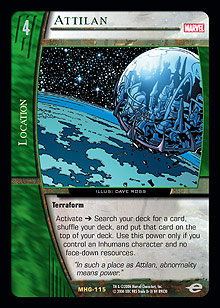 The mulligan condition is very easy: mulligan for Attilan or a way to get it. This will usually mean a hard mulligan for San or an Inhumans search card (Lockjaw or The Great Refuge). With twelve cards meeting the mulligan condition, you shouldn’t miss very often. Once you have Attilan online, you can use it to find any other cards that you might need.
The mulligan condition is very easy: mulligan for Attilan or a way to get it. This will usually mean a hard mulligan for San or an Inhumans search card (Lockjaw or The Great Refuge). With twelve cards meeting the mulligan condition, you shouldn’t miss very often. Once you have Attilan online, you can use it to find any other cards that you might need.
When playing The Source, you need to be very conscious of timing it according to your opponent’s actions. With decks that try to abuse Poison Ivy or Ahmed Samsarra, you want to use The Source in response to your opponent using those effects. While it won’t stop the opponent from fetching a location, it will allow you to nuke a wayward copy of Devil’s Due or Straight to the Grave in the resource row before he or she can KO it for a location search effect.
Against a Crisis Doom deck, you want to use The Source on Crisis on Infinite Earths in response to your opponent declaring his or her intent to recruit Dr. Doom, Diabolic Genius. Most players will KO their Dr. Doom, Richards’s Rival to replace Crisis on Infinite Earths in response to you playing The Source (since they will lose their 3-drop anyway). Still, this is a great trade for you, as you get to trade a card in your resource row for your opponent’s 3-drop. Besides, you’ll invariably get another shot at Crisis on Infinite Earths later in the game!
That’s all, folks. Have fun creating pandemonium with The Source. While you may not be playing the most powerful deck in the game, you’ll have a world of fun destroying critical opposing resources. There’s only one word to describe the look of chagrin on an opponent’s face when you remove all four copies of Enemy of My Enemy from his or her deck: priceless!
* From a flavor perspective, it would be pretty neat to see Sturmer perform some team attacks with his fellow canine, Lockjaw. Double dog attack FTW!
Michael Barnes (AKA BigSpooky) is an avid Vs. System player who is a founding member of Team Alternate Win Condition (TAWC). When he isn’t concocting crazy deck ideas that no sane person would think of, he occupies his spare time working as an accountant in Dallas, TX. Any questions, comments, suggestions, or “Blah, blah, blah . . . tea and scones” that you might have for Michael can be sent to him at BigSpooky1@hotmail.com.